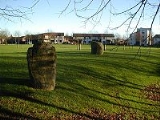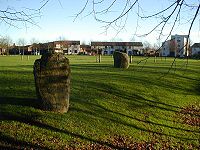
Balfarg
Encyclopedia
Balfarg is a prehistoric monument complex in Glenrothes
in Fife
, Scotland
.
 The Balfarg henge
The Balfarg henge
is part of a larger prehistoric ceremonial complex. It contains the remnants of a stone circle
which has been partly reconstructed.
The Balfarg henge was excavated between 1977 and 1978 by Roger Mercer
prior to the development of a new housing estate, work which established that the two extant standing stone
s were part of a circle that stood within the henge. The two surviving specimens lined the north-west oriented entrance to the henge. Mercer's report is available online. http://ads.ahds.ac.uk/catalogue/adsdata/PSAS_2002/pdf/vol_111/111_063_171.pdf
Within the 64.9m diameter henge were found broken Neolithic
pottery, burnt wood and bone which had been dumped on the site prior to the erection of a 25m wide timber circle
of 16 wooden posts. Two especially large portal timbers stood on the west side of the circle. It is likely that the henge was built after these phases of activity. Grooved ware
pottery found in the posthole
s dates to around 2900 BC. Some of the vessels may have been used to hold black henbane
(Hyoscyamus niger) which is a poison but also a powerful hallucinogen. This discovery is briefly explored in the journal Antiquity in the article 'The use of henbane as a hallucinogen at Neolithic 'ritual' sites: a re-evaluation.'
Five further concentric post rings had also been erected outside and inside the main wooden circle although these were made from narrower timbers and may have supported hurdling or a palisade
.
Later during the site's use the timber circle was replaced by two concentric stone circles, again with an entrance to the west and some time after this the henge was constructed. Around 1900 BC a pit was dug in the centre of the stone circles and in it was placed the body of a young man along with a flint knife and a handled beaker
.
Later excavation between 1983 and 1985 by Barclay and Russell-White demonstrated that there were scatters of earlier Neolithic pits round the Balfarg henge. These excavations also discovered a second henge, which surrounded a Neolithic timber mortuary enclosure. A second such timber structure lay just outside the henge, partly overlain by a complex of two burial cairns. Barclay & Russel-White's report is available online http://ads.ahds.ac.uk/catalogue/adsdata/PSAS_2002/pdf/vol_123/123_043_210.pdf
Nearby is the Balbirnie stone circle, which is also part of the complex.
A Guide to the stone circles of Britain, Ireland and Brittany, Yale, 1995
Glenrothes
Glenrothes is a large town situated in the heart of Fife, in east-central Scotland. It is located approximately from both Edinburgh, which lies to the south and Dundee to the north. The town had an estimated population of 38,750 in 2008, making Glenrothes the third largest settlement in Fife...
in Fife
Fife
Fife is a council area and former county of Scotland. It is situated between the Firth of Tay and the Firth of Forth, with inland boundaries to Perth and Kinross and Clackmannanshire...
, Scotland
Scotland
Scotland is a country that is part of the United Kingdom. Occupying the northern third of the island of Great Britain, it shares a border with England to the south and is bounded by the North Sea to the east, the Atlantic Ocean to the north and west, and the North Channel and Irish Sea to the...
.

Henge
There are three related types of Neolithic earthwork which are all sometimes loosely called henges. The essential characteristic of all three types is that they feature a ring bank and ditch but with the ditch inside the bank rather than outside...
is part of a larger prehistoric ceremonial complex. It contains the remnants of a stone circle
Stone circle
A stone circle is a monument of standing stones arranged in a circle. Such monuments have been constructed across the world throughout history for many different reasons....
which has been partly reconstructed.
The Balfarg henge was excavated between 1977 and 1978 by Roger Mercer
Roger Mercer
Roger Mercer is a British archaeologist whose work has concentrated on the Neolithic and Bronze Age of the British Isles.Between 1970 and 1973 he led the excavations at Carn Brea in Cornwall and then went on to direct the excavations at Hambledon Hill and Grimes Graves, a Neolithic flint mine...
prior to the development of a new housing estate, work which established that the two extant standing stone
Standing stone
Standing stones, orthostats, liths, or more commonly megaliths are solitary stones set vertically in the ground and come in many different varieties....
s were part of a circle that stood within the henge. The two surviving specimens lined the north-west oriented entrance to the henge. Mercer's report is available online. http://ads.ahds.ac.uk/catalogue/adsdata/PSAS_2002/pdf/vol_111/111_063_171.pdf
Within the 64.9m diameter henge were found broken Neolithic
Neolithic
The Neolithic Age, Era, or Period, or New Stone Age, was a period in the development of human technology, beginning about 9500 BC in some parts of the Middle East, and later in other parts of the world. It is traditionally considered as the last part of the Stone Age...
pottery, burnt wood and bone which had been dumped on the site prior to the erection of a 25m wide timber circle
Timber circle
In archaeology, timber circles are circular arrangements of wooden posts interpreted as being either complexes of freestanding totem poles or as the supports for large circular buildings-British Isles:...
of 16 wooden posts. Two especially large portal timbers stood on the west side of the circle. It is likely that the henge was built after these phases of activity. Grooved ware
Grooved ware
Grooved ware is the name given to a pottery style of the British Neolithic. Its manufacturers are sometimes known as the Grooved ware people. Unlike the later Beaker ware, Grooved culture was not an import from the continent but seems to have developed in Orkney, early in the 3rd millennium BC, but...
pottery found in the posthole
Posthole
In archaeology a posthole is a cut feature used to hold a surface timber or stone. They are usually much deeper than they are wide although truncation may not make this apparent....
s dates to around 2900 BC. Some of the vessels may have been used to hold black henbane
Henbane
Henbane , also known as stinking nightshade or black henbane, is a plant of the family Solanaceae that originated in Eurasia, though it is now globally distributed.-Toxicity and historical usage:...
(Hyoscyamus niger) which is a poison but also a powerful hallucinogen. This discovery is briefly explored in the journal Antiquity in the article 'The use of henbane as a hallucinogen at Neolithic 'ritual' sites: a re-evaluation.'
Five further concentric post rings had also been erected outside and inside the main wooden circle although these were made from narrower timbers and may have supported hurdling or a palisade
Palisade
A palisade is a steel or wooden fence or wall of variable height, usually used as a defensive structure.- Typical construction :Typical construction consisted of small or mid sized tree trunks aligned vertically, with no spacing in between. The trunks were sharpened or pointed at the top, and were...
.
Later during the site's use the timber circle was replaced by two concentric stone circles, again with an entrance to the west and some time after this the henge was constructed. Around 1900 BC a pit was dug in the centre of the stone circles and in it was placed the body of a young man along with a flint knife and a handled beaker
Beaker (archaeology)
A beaker is a small ceramic or metal drinking vessel shaped to be held in the hands. Archaeologists identify several different types including the butt beaker, the claw beaker and the rough-cast beaker, however when used alone the term usually refers to the pottery cups associated with the European...
.
Later excavation between 1983 and 1985 by Barclay and Russell-White demonstrated that there were scatters of earlier Neolithic pits round the Balfarg henge. These excavations also discovered a second henge, which surrounded a Neolithic timber mortuary enclosure. A second such timber structure lay just outside the henge, partly overlain by a complex of two burial cairns. Barclay & Russel-White's report is available online http://ads.ahds.ac.uk/catalogue/adsdata/PSAS_2002/pdf/vol_123/123_043_210.pdf
Nearby is the Balbirnie stone circle, which is also part of the complex.
Source
Burl, AAubrey Burl
Harry Aubrey Woodruff Burl MA, DLitt, PhD, FSA, HonFSA Scot is a British archaeologist most well known for his studies into megalithic monuments and the nature of prehistoric rituals associated with them. Prior to retirement he was Principal Lecturer in Archaeology, Hull College, East Riding of...
A Guide to the stone circles of Britain, Ireland and Brittany, Yale, 1995

